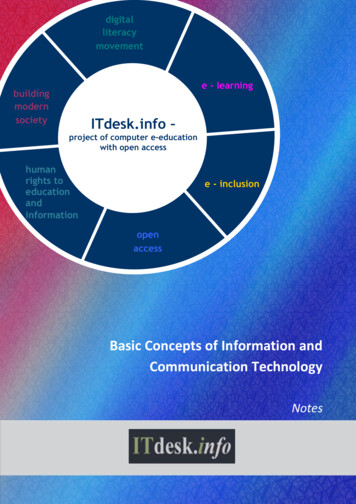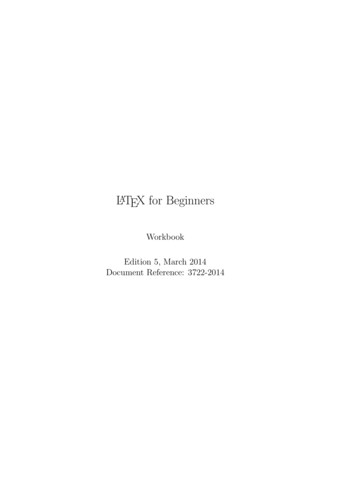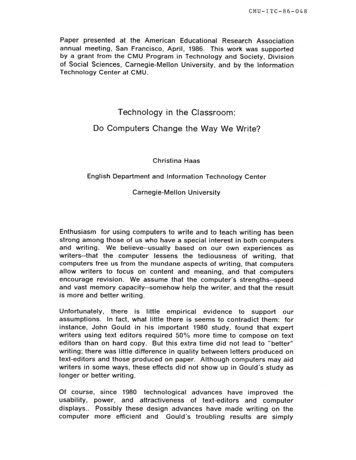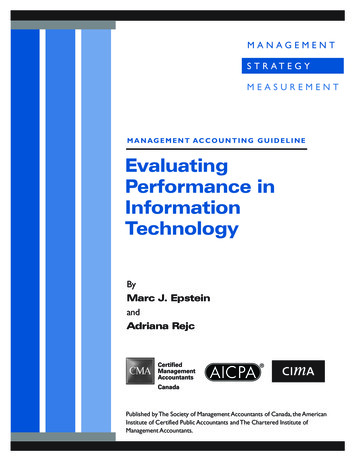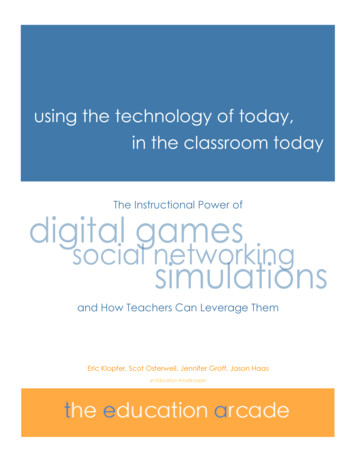
Transcription
using the technology of today,in the classroom todayThe Instructional Power ofand How Teachers Can Leverage ThemEric Klopfer, Scot Osterweil, Jennifer Groff, Jason Haasan Education Arcade paper
The Education ArcadeMassachusetts Institute of TechnologyEric Klopfer, Scot Osterweil, Jennifer Groff, Jason Haas copyright 2009http://creativecommons.org/licenses/by/3.0
I nt r od uc ti onWhat is good learning? That may be a subjective question. But it’s likely that many educators would give answersthat fall in the same ballpark students collaborating and discussing ideas, possible solutions project-based learning, designed around real world contexts connecting with other students around the world, on topics of study immersing students in a learning experience that allows them to grapple with a problem,gaining higher-order thinking skills from pursuing the solution To many educators, these notions are music to their ears. Would it seem terribly strange then to hear that students indeed are doing these things regularly outside of their classrooms? While Timmy or Susie may not be running home from school saying, “What fun, deeply-engaging learning experience can we do today?”, they are engaging with new technologies that provide them with the same opportunities. Every day, many students arespending countless hours immersed in popular technologies—such as Facebook or MySpace, World of Warcraft,or Sim City—which at first glance may seem like a waste of time, and brain cells. But these genres of technologies—Social Networking, Digital Gaming, and Simulations—deserve a second, deeper, look at what’s actually going on. When you hear ”MySpace” or “World of Warcraft,” what do they bring to mind for you? What emotions do youassociate with them? Have you heard of them before? Your students have, and they almost certainly have strongopinions about them. You don’t need to be a teenager to use or understand these technologies, or to use them inyour classroom. Market research data indicates that many a normal, middle-aged adult1 uses these technologieswith frequency. The fact is, you can be 17, 35, or 60, and when you begin to engage with them and observewhat’s really going on, you can begin to see that these technologies are more than just entertainment. Thesetechnologies are already demonstrating how they impact the way we think, learn, and interact—and they are alsodemonstrating the tremendous potential they have in these areas as well. The emergence of social networkingtechnologies and the evolution of digital games have helped shape the new ways in which people are communicating, collaborating, operating, and forming social constructs. In fact, recent research is showing us that thesetechnologies are shaping the way we think, work, and live. This is especially true of our youngest generations—those arriving at classrooms doors, soon to be leaving them and entering the workforce and society-at-large.Our newest generation – currently in K-12 – is demonstrating for us the impact of having developed under thedigital wave. These youth have been completely normalized by digital technologies—it is a fully integrated aspectof their lives (Green & Hannon, 2007). Many students in this group are using new media and technologies to cre1 According to the Entertainment Software Association in 2008, the average game player is 35 years of age.usi ng th e t ech nol og y o f t oday , i n t h e clas sroo m t oday1
ate new things in new ways, learn new things in new ways, and communicate in new ways with new people—behaviors that have become hardwired in their ways of thinking and operating in the world. Green and Hannongive an excellent example of this, “Children are establishing a relationship to knowledge gathering which is aliento their parents and teachers” (2007, p. 38).Not surprisingly, this “transformation” has serious implications for us in the space of education. Nearly all institutions – business, industry, medicine, science and government – have harnessed aspects of these technologies fordecades. Games and simulations have been a key component of training doctors and military personnel, but evenbusinesses like PricewaterhouseCoopers used a game about a mining company in outer space to teach its employees about derivativesi. Although that may seem a bit “off the wall,” the fact is major corporations, the Department of Defense, and the medical community would not use these tools if they were not highly effective.Although these examples are mainly centered on training purposes, there are deeper educational benefits to digital simulations and games. Yet educational institutions have been reluctant to embrace these technologies. Likewise, where schools have often shied away from giving students an online identity in a digital networking platforms to increase opportunities for learning, professional organizations are leveraging networking technologies toincrease collaboration, knowledge-sharing, and production amongst their employees. Traditionally, education hasbeen impeded by the security and other potential dangers of employing social networking technologies. Theseconcerns should not be ignored; however neither should these tools due to these concerns. Advances in thesetechnologies continue to afford us new ways to manage the potential dangers.Simulations, digital gaming, and social networking technologies have all definitely suffered the same public relations problems that all new technologies do. However, there are countless examples of these technologies demonstrating their educational value to other industries, confirming the powerful learning opportunities and advantages they afford. It is our position that these technologies are safe, valuable tools schools must take seriously.Of course, changing instructional approaches is no easy task, particularly when technology is involved. Adoptingand integrating technology-based instructional strategies has a long history of challenges, but with it has come agreat understanding of how to achieve success with them. In the contents to follow, we will discuss: the background and affordances of Simulations, Digital Games, and Social Networking; the cognitive implications of these technologies; specific challenges with using these tools in the classroom, as well as strategies for overcoming these challenges in order to achieve successful learning experiences; and the future of these technologies and their impact and learning and teaching.2usi ng th e t ech nol og y o f t oday , i n t h e clas sroo m t oday
E v olu ti on, N o t R ev olu tio nTechnology can have a reciprocal relationship with teaching. The emergence of new technologies pushes educators to understanding and leveraging these technologies for classroom use; at the same time, the on-the-groundimplementation of these technologies in the classroom can (and does) directly impact how these technologiescontinue to take shape.While many new technologies have emerged throughout history, so has the cry for educators to find meaningfulways to incorporate these technologies into the classroom – be it the typewriter, the television, the calculator, orthe computer. And while some professional educators may have become numb to this unwavering ‘call’ – and forgood reason – it is crucial to consider that the excitement over games and social networking isn’t just businessand industry “crying wolf.” Indeed, those previous technologies have a powerful place in instruction and the classroom; but without them, strong lessons and learning objectives can still be achieved. With these more recenttechnologies, we think educators should take the call, even if only on a trial basis.Undoubtedly, without these recent technologies (i.e. digital games, Web 2.0, etc.) in the classroom, strong lessonscan still be achieved, but there’s a sharp disconnect between the way students are taught in school and the waythe outside world approaches socialization, meaning-making, and accomplishment. It is critical that educationnot only seek to mitigate this disconnect in order to make these two “worlds” more seamless, but of course also toleverage the power of these emerging technologies for instructional gain.Of course, as a result of these assaults on formal education, those in the “outside world” are often quick to pounceon educators and the way education is (perceived to be) conducted in U.S. classrooms. This bandwagon perspective has become a mounting dialogue, charging the field of education with the imperative for a revolution—radical transformation of its system and practices. While it is clear that education is no different from the other sectors in its need to adapt and modify to our transforming world, it is also clear that many educators currently already implement excellent teaching practices and are able to skillfully create dynamic learning environments.Attacking educators’ current practices combined with the lack of acknowledgment of current best practices onlyhinders the growth of the education sector. There are countless educators who are masters at their craft, currentlyemploying an array of exceptional instructional strategies. Lauding and building upon these strategies is critical toeffective growth in the education sector in order to bridge the aforementioned divide. We advocate for an evolution in educational practices and approaches to instruction, which not only align with the processes and operations of the world outside of school, but also leverage the emerging power and potential of these new processesand technologies. Attending to this end of the technology-teaching relationship has the additional benefit ofhelping to shape emerging technologies that is most effective for cognition and instruction.usi ng th e t ech nol og y o f t oday , i n t h e clas sroo m t oday3
N ew T echn ol ogi e s. .N ew Lea rningWhy digital gaming, simulations, and social networking? Simply put, these technologies afford us the ability toconvey concepts in new ways that would otherwise not be possible, efficient, or effective, with other instructionalmethods. In other words, these technologies don’t just help us teach the old stuff in new ways – they can alsohelp us teach new stuff in new ways. Below we provide a brief description of these technologies; populareducational and non-educational examples of each, and what researchers and practitioners are finding abouttheir potential and impact on teaching and learning.Digital GamingDigital games encompass much more than your computer’s Solitaire or Nintendo’s Super Mario Bros. Over the lastdecade, the genre of digital games has exploded to include numerous platforms and designs. Digital games,whether computer-, game console-, or handheld-based, are characterized by rules, goals & objectives, outcomes& feedback, conflict/ competition/challenge/opposition, interaction, and representation of story (Prenksy, 2001) ormore simply, “Purposeful, goal-oriented, rule-based activity that the players perceive as fun” (Klopfer, 2008). Theyare distinguished by two key elements: (1) an interactive virtual playing environment, and (2) the struggle of theplayer against some kind of opposition.Gaming is already a widespread activity in our culture —more than 45 million homes have video-game consoles(Feller, 2006). Over 154 million Americans play video games (that’s about half of the country’s population) (Emrich,2005). In a given week, the average eighth-grade boy will play video games for about 23 hours, while the averagegirl will play about 12—that’s even more time than they spend watching TV (Dawley, 2006). Therefore, one of themost obvious benefits to using these technologies for learning is that students are often already familiar withthese interfaces and the “language” of interacting with and utilizing them.Both inside and outside the classroom, some strong examples of powerfully engaging gaming models haveemerged. Some have been used quite a bit in the educational setting, while others have mainly garnered popularity in pop culture. We outline some examples of both below.CIVILIZATIONThis commercial, off-the-shelf (COTS) game originally appeared in 1991. As a result of the game’s popularitydesign, multiple installations in the series have been developed. The goal of the game is to successfully buildan enduring empire. The latest version, CIVILIZATION IV, allows players to form teams in order to increase collaboration and strategy efforts. In this turn-based strategy game, players must make decisions for their civilization around societal development and diplomacy—including when and where to build new cities, whatsocietal advances in knowledge should be sought (and when), and how to handle adversarial and nonadversarial neighboring civilizations. At the onset of the game, players even have the choice of which civilization to play—Aztecs, Romans, Mongols, etc. As time advances in the game, new technologies emerge(such as pottery and nuclear fission) and civilization leaders have the choice to try to capitalize on thesetechnologies or not.4usi ng th e t ech nol og y o f t oday , i n t h e clas sroo m t oday
The cultural popularity of CIVILIZATION has been tremendous, howCivilizationever it’s also been highly touted by those in the educational space.Kurt Squire and folks at the Games, Learning and Society grouptype: commercialhave extensively written about, created materials for, and implegame complexity: moderatemented C IVILIZATION in educational settings. They contend thatoverview: players select a historiplaying a game like CIVILIZATION can be a profoundly powerful waycal civilzation to develop in afor learning about history, and that through game-play players cansustainable waygained advanced terminology and knowledge of geography,goal: to be the dominant,principles of history, and generally increase their interest in thissurviving civilizationarea of study. Their website supporting this work[http://civworld.gameslearningsociety.org] has numerous resources for the educational implementation ofCIVILIZATION—many of which have been contributed by students who have taken an interest in the game.Games like CIVILIZATION have an easier onramp to the educational space than other COTS games that are abig hit in popular culture that at first glance may give off the guise that they would have zero educationalvalue. However many of these types of games have also been able to demonstrate their tremendous abilityto cultivate key skills, which although may not be directly related to a content area, they are critical higherorder thinking skills applicable in all areas of life. Perhaps the most prominent example of this is the online,multiplayer game WORLD OF WARCRAFT (WO W).While not targeted at education, nor seeking to cover any type of educational content, Green & Hannon(2007) cite multiple skills associated with being a “guildmaster” (one of the roles in WOW): attracting, evaluating, and recruiting new members; creating apprenticeship programs;World of Warcraft (WoW)type: commercial (MMORPG) orchestrating group strategy; andgame complexity: variable managing disputes.overview: a fantasy role-playinggame, like Dungeons and Dragons, played over the Internetwith millions around the worldAs you might imagine, these are frequently cited as being skillshighly sought after in the workplace. Both of these games – CIVILIZATION and WORLD OF WARCRAFT – provide us with clear demonstrations of the educational implications and possibilities of COTS—and as educators continue to adopt and adapt these games, wewill in turn further learn the benefits and best designs of these games.goal: outfit and improve yourcharacter through quests bothcooperatively and competitivelywith other players.LURE OF THE LABYRINTHDesigned to appeal to youth like a COTS game, the LURE OF THE LABYRINTH was most certainly created witheducational intentions. Designed at the MIT Education Arcade in development collaboration with MarylandPublic Television, Fablevision, Johns Hopkins University, and Macro International, LABYRINTH is funded by theU.S. Department of Education with a primary goal of enhancing pre-algebra mathematics learning, and asecondary goal of improving literacy. LABYRINTH is a web-based, long-form puzzle adventure game playedover many sessions. The game’s storyline is a persistent narrative that evolves over time, where the player’scharacter enters the game looking to recover a lost pet and subsequently is led by clues through a fantasyworld—an underground factory populated by mythical monsters who are stealing pets. By the game’s conclusion, players will have recovered their own pets, freed many others, and halted the monsters’ plans by deusi ng th e t ech nol og y o f t oday , i n t h e clas sroo m t oday5
stroying their factory using algebra. As a result of the player exploring this space, learning how to navigateit, and solving puzzles with mathematical reasoning, players can earn enough points to free their pet.These puzzles are the central mechanic of the game. Often, players will not succeed on a puzzle on the firsttry, and the second time the puzzle is encountered the piece will be different (although the dynamic, or puzzle rule, will still be the same). Throughout the game, players are in communication with teammates via anin-game message board. Players seek or give advice about solving individual puzzles or the overarchinggame goals. However, since no puzzle is ever the same twice, help for teammates can only offer meta-levelthinking about the game. This skill of articulating the solution, makes them valuable team members, andalso builds skills required on many standardized assessments. Ultimately, these puzzles were designed tohelp students embody the thinking, processes, and habits of mind of a scientist, mathematician, or engineer—which include: probing (sometimes random, sometimes focused), observing one’s environment in response to stimuli introduced, forming hypotheses, and testing and altering single variables.FOR MORE EDUCATIONAL G AMES, GO TO WWW.EDUCATIONARCADE.ORGWhile additional high quality research on the effects of gaming is needed, there are important reasons for educators to engage with digital games. Initial reports show that gamers have well-developed skills including enhancedvisual perception. Researchers such as Patricia Marks Greenfield also argue that habitual playing of video gamesresults in the development of new cognitive abilities that translate into the key skills for our transformed world(Facer, 2003): The ability to process information very quickly; The ability to determine what is and is not of relevance to them; The ability to process information in parallel, at the same time and from a range of different sources; Familiarity with exploring information in a non-linear fashion; A tendency to access information in the first instance through imagery and then use text to clarify, expand, and explore; Familiarity with non-geographically bounded networks of communication; and A relaxed approach to ‘play,’—the capacity to experiment with one’s surroundings as a form of problemsolving (Jenkins, Purushotma, Clinton, Weigel & Robison, 2006).Other researchers have found that games improve skills in communication and collaboration, problem-solving,and various number-related skills (McFarlane, Sparrowhawk, & Heald, 2002). Gee (in press) expands the skill set potentially (as it can vary from game to game) developed by games to include:6usi ng th e t ech nol og y o f t oday , i n t h e clas sroo m t oday
pattern and rule recognition; ‘embodied empathy’ for a complex system [”where a personseeks to participate in and within a system, all the while seeingand thinking of it as a system and not just local random events”p. 5-6]; fluency with ‘cross-functional affiliation’ [operating in a groupto achieve a goal, by using specialist and general commonknowledge necessary for group operation(s)]; and illumination of attributes of human cognition, distributed intelligence, and situated meaning.Dipl o mac yty pe : commercialgame c om pl exity: lowerov ervi ew : simulates the politicaland military conditions of Europein the late 1800s/early 1900sgoal: take over EuropeWhat all these skills represent are the ways in which individuals are increasingly required to effectively operateand function in our highly digital world. Any educator can tell you ample anecdotes of where a critical piece to aclassroom project was accessing, sorting, and processing information, exploring possibilities to identify problemsolutions, and collaborating with others (both live and asynchronously) in order to achieve a goal. Although theaforementioned capacities don’t show up in all state standards just yet, national organizations such as AASA havealready identified and supported these skills as critical capacities for 21st century operation.Meet Ross 7th Grade Central Subject TeacherAt a traditional independent school in Cambridge, Massachusetts, the curriculum is anything but digital. Althoughtechnology is valued, this pre-K – 8 school is built upon the philosophy of “education through meaningful realworld play and exploration.” It may seem strange then that Ross has embraced and been wildly successful withdigital game-based education in his classroom. For the past several years, Ross has been using commercial, content-related games like DIPLOMACY in his classroom. Although he believes the ideal scenario is to partner up students on one computer and each team plays the role of a country, he has also played the game as a whole classat the front of the room via one computer and a projector, which serves as the content from which Ross facilitatesthe activity. For Ross, there are numerous benefits to playing DIPLOMACY in the classroom versus his traditional instructional methods—one of the strongest benefits of the game is the framing of the content as the students explore and interact with the scenario-at-hand (such as the political causes of WWI as found in DIPLOMACY). Thisserves a profoundly engaging vehicle for covering the content in his curriculum. However, Ross has observed inhis classes that DIPLOMACY provides additional benefits that would otherwise be challenging for him to emulate: teaches students about the skill of negotiation, teaches students how to solve problems collaboratively, and teaches students to be mindful of their actions/impact on others (an attribute of Systems Thinking).Ross sees these habits of mind, or conceptual knowledge, as the greatest outcome of the learning experience.“The conceptual knowledge is critical because if you can grasp that, then you can transfer skills and morph intousi ng th e t ech nol og y o f t oday , i n t h e clas sroo m t oday7
other domains, roles, and work more easily. With digital games, students get to experience the concepts versuspassively watching a video on it."The learning benefits described by Ross seem clearly advantageous. But is there an inherent benefit for Ross? According to him, having tools like digital games has only enhanced his teaching. “Games don’t teach the content it teaches [students] the conceptual knowledge and sets the environment for you to teach what you want.”SimulationsAlthough analogous to digital games and often included in the gaming spectrum, simulations are “analog[ies] ofa real world situation[s]” (Prensky, 2001, p. 128), as they recreate a modeled or modified version of a real worldsituation. One essential aspect that separates digital games from simulations is the lack of game dynamics or the“win state” that exists in digital games. Some examples of simulations include:MOLECULAR WORKBENCHAs technology has improved, so has the quality of simulations developed for education. Developed by theConcord Consortium in Concord, Massachusetts, MOLECULAR WORKBENCH provides interactive, visual simulationsto aide in teaching simple and complex science concepts, such as dynamic molecular structures (Tinker & Xie,2008). MOLECULAR WORKBENCH also has a unique additional instrument—a reporting and assessment system—which can be used by teachers to can collect data and measure learning with models and simulations.STARLOGO: THE NEXT GENERATION (STARLOGO TNG)Simulations do a great job of helping learners to visualize and conceptualize complex phenomena. However,the learning can be even more powerful when the student is creating and altering a simulation they themselves are building. StarLogo TNG is an open-ended tool that allows the user to do just that. A 3D modelingand simulation software, StarLogo TNG is a user-friendly programming language represented by coloredblocks that fit together like puzzle pieces. The programming possibilities are seemingly endless, and numerousteachers in math and science have created an array of applications with it—including a model of a health epidemic to a simulation of the dynamics between fish and plankton (Klopfer, Scheintaub, Huang, & Wendel,2009; Klopfer & Scheintaub, 2008a & 2008b).SIMCITYOne of the first, and biggest, COTS simulation games to come onto the market was SIMCITY —where the objective is to design and create a thriving, sustainable city. Players designate which land is residential, industrial, orcommercial, and as the mayor of their city they are forced to confront issues of pollution, crime, waste management, transportation, and so on. By building their own city, they are in control of the various parts thatmake up a city system, helping to underscore concepts of system dynamics. The scenario that this presents allows for direct connections to economics, math and science. SIMC ITY also comes with built in scenarios—realworld cities with the occurrence of a fictional event (although a few scenarios are based on actual events inhistory)—such as “Boston 2010” where there is a nuclear meltdown in the city and the mayor must containtoxic areas and rebuild, and “Hamburg, Germany, 1944” where bombing from WWII has destroyed much of the8usi ng th e t ech nol og y o f t oday , i n t h e clas sroo m t oday
city and the mayor must guide the city through the end of the war. These scenarios serve as excellent jumping-off points for your instructional endeavors and curricular needs.For simulations to be successful at whatever their goal, they need structural elements to give them shape, andthis often comes from the rules of game-play and/or digital enhancement (Prensky, 2001). Many of the samebenefits and skills previously detailed around digital games are also true for simulations. For simulations to be effective instructionally in the classroom, they, like most instructional tools, need guided facilitation from theteacher. However, the beauty of simulations is that they create learning opportunities and experiences that mightotherwise never be able to be created in the traditional classroom—learning experiences that are authentic models of real world situations, allowing for strong transfer of understanding to real world situations.Truly, creating authentic learning experiences is perhaps the most critical aspect and benefit to digital games andsimulations—bridging the all-too-well-known gap between the classroom and the real world. The learning hasmeaning and relates to the real world because it is modeled on the systems of the real world—not broken down,compartmentalized, and stripped from context as many lessons must be in order to be compacted into a 45minute period. The majesty of well-designed learning games and simulations is that through technology theypresent a scaffolded, simulated world in a manner that makes it more digestible and engaging for students. Shaffer explains, “computers.let us work with simulations of the world around us. and these simulations let us playwith reality by creating imaginary worlds where we can do things that we otherwise couldn’t do at all” (2006, p. 9).Not only is this highly motivating and engaging for students, it allows students to retain, connect and transferlearning from these experiences to future learning and experiences.Meet Hal & Kali 12th Grade Physics TeachersSimulations in physics class? That doesn’t seem out of place. But in the classrooms of Hal and Kali in Lawrence,Massachusetts, simulations are much more than a digital depiction of “trajectory” or Newton’s laws of motion. Forthe past eight years, veteran educator Hal has been using STARLOGO TNG (described above) to create digital simulations to demonstrate the principles of complex concepts such as evolution or the factors in a forest fire—twoconcepts that would otherwise be difficult for the students to experience.Helping students gain conceptual understanding of these challenging concepts is just one major outcome oftools like STARLOGO TNG—but since it also allows users to create and program their own simulations, students canbe creative problem-solvers, and demonstrate mastery of the concepts by altering the simulation based upontheir understanding of how it works. For Hal, this coupling the simulation with programming in his class is themost powerful manifestation of experiential learning.“I will give students a partial simulation of a forest fire. The kids then manipulate the simulation to program a solution—such as programming a fire fighter. Kids can then compare these multiple solutions.” According to Hal, "it'sdifferent from the science test I just gave," because it allows him to pose more interesting questions and to allowstudents to generate multiple correct answers instead of looking for one "correct" answer.usi ng th e t ech nol og y o f t oday , i n t h e clas sroo m t oday9
A few years ago, a new colleague named Kali joined the school’s science department. Although Kali was just getting her feet wet as a classroom teacher, the two found that collaborating around a tool like STARLOGO TNG created great synergy that elevated both of their instructional practices. Although each
While many new technologies have emerged throughout history, so has the cry for educators to find meaningful ways to incorporate these technologies into the classroom – be it the typewriter, the television, the calculator, or the computer. And while some professional educators



